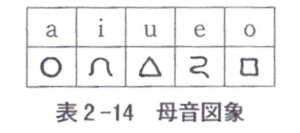
Wakauta no Aya
We continue reading the aya that we introduced earlier.
Amateru and Hiruko
The 8th Amakami Amateru learned the meaning of the Motoake from his grandfather Toyoke-kami who designed the Motoake chart to teach cosmology. In the verse, Amateru and his sister Hiruko appear. They speak of their parents, the Hutakami Isanagi and Isanami, who taught the Awauta song and thus performed kuni-umi. The word umi means to give birth to. The word kuni can mean land or nation. In post-Wosite days, kuni-umi became the myth of how the islands of Nihon were created by the Hutakami. This aya shows that Hiruko is confused because she is thinking of kuni-umi as giving birth to land. Amateru explains what kuni-umi really means — giving birth to a nation — and how it was done.
This fragment contains a profound teaching called Nekoye. Nekoye is the process of transforming ordinary sound ne into speech koye. It lies at the basis of the Wosite language and is closely connected to the cosmology of Motoake. We will give an explanation of the verse. Line numbers are given in parentheses; ff indicates following lines.
Nekoye. Hiruko listens to Amateru’s talk about Nekoye. She wants to know more about the beginning of Nekoye (Nekoye no u-i no). Here is Amateru’s explanation (63ff). Amateru teaches the A no Osite as follows. Ame and Tuti separate to make human form (68). At first, humans only made sounds (ne). When they stopped up their breath by closing the mouth, air blows out the nose (71). According to the A no Osite, this air-breath divides into three: clear u, light tirin, middle nu (74). This relates to the three-part creation of things: in Cosmos, of human life, and sound/speech.

Then the discussion turns to the process of hatsuon (pronunciation). Note that the shape of the mouth, as it pronounces the vowels, is similar to the shape of the glyphs. The sound of A is made. Moon-making Earth is wrapped tightly (musuhu) by strings (fusa) (76). The tamanowo cord births the Wa of u-A (77). The character of A separates into A-wa with A on outside and Wa on inside (78). The teaching also says that A breaks up into i, then e (80). “Breaks up” refers to the shapes of the glyphs of the five vowels, i.e., the shapes break up or change, in this order: A I Wa. It also refers to the shape of the mouth when saying those sounds. Then Wa becomes o sound. The 5 sounds, the 5 energies are: A is utuho, i is kase, u is ho, e is mitu, and o is hani (83). From the human in-breath, the 5 sounds differentiate into the 48 sounds (85). Thus the Law of Nekoye is revealed (Nekoye no miti akite) (86). Then we can say that Awa (Awa-kuni, the Biwako area) is the placenta (yena) of the kuni (Yamato), giving birth to the eight islands of Yamato (Yamato Yasima) (88).
Nekoye and Kuni-umi
Birthing kuni (89-106). Hiruko says to her brother: In the past, our parents the Hutakami gave birth to three sons and a daughter. How could they give birth to a kuni? (92). Amateru answers: From the start, the people were tasked to spread the Awauta. All went well in organizing the kuni and transforming kuni land into kuni nation. Having kotoba language and being able to communicate with each other, people are able to cooperate and coordinate their activities such as for making rice fields. Auwa is the yena of koye (96), the aya states. Awauta makes the eight shapes of human body (katati) (98). The explanation of how to make ne into koye was taught by Amateru to Hiruko. Hiruko understood and, as Wakahime, continued the work of the Hutakami as she spread the Awanouta and the teaching of Nekoye.
Discussion. The Motoake creation chart was designed by the sage Toyoke-kami, father of Isanami and grandfather of Amateru and Hiruko. Toyoke-kami taught the meaning of Motoake to Amateru. The Amoto center of the Motoake creation chart contains the Auwa (A-U-Wa). The first ring of 8 Akuta-kami protects Amoto and the throat. The second ring of 8 Anami-kami produce and protect sound. The two outer rings of 32 Misohu-kami create and protect the human body. All kami together make and protect everything, and everything protects the kami.
The teaching is that sound ne is produced, and by the action of the 48 kami, sound becomes human speech koye and language kotoha. We may imagine the concept as follows. Ne is like invisible koye. Ne becomes koye when Auwa serves as the yena or tamanowo, the placenta or the spirit cord, and the Misohu-kami make koye in the physical world. In a sense, Auwa is changing into ne, and ne is changing into koye. Therefore, Auwa is changing into koye, and koye is originally Auwa. This profound teaching is describing how human beings in the physical world are created, and how the Original Presence of Auwa breathes spirit into the ne of humans to convert it into koye of language.
The Hutakami performed kuni-umi, gave birth to kuni, by teaching the people how to convert ne into koye. The result is that the people could speak a common language with which they could communicate with each other. Then they could join together in their work such as raising crops and constructing houses. The unification of people is the creation of kuni.
This, then, is the story of how kuni land became kuni nation through the Awauta of the Hutakami. In the process of kuni-umi, they taught Nekoye. Nekoye is the power of speech for humans to communicate and collaborate. Amateru and Hiruko Wakahime continued the work of teaching Motoake and Nekoye. Amateru in addition applied the Motoake chart to the process of Hutomani (Futomani).
The photo shows the Koshikiiwa shrine to Wakahime in the Rokko mountains of Kobe. Credit: Okunomichi.
***